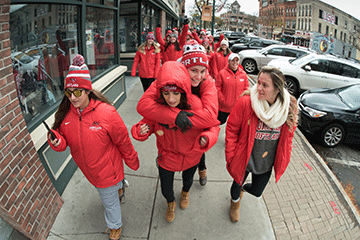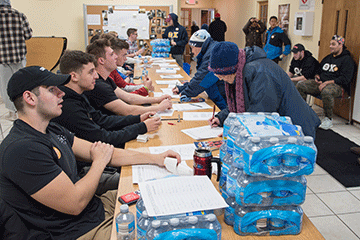
10/05/2022
Last October, 15 teams of SUNY Cortland students raised more than $10,000 to combat world hunger. It was the strongest student effort among more than 2,000 CROP Hunger Walks held across the United States.
This year, as bloody conflicts, COVID-19, climate shocks and global inflation have put more than 345 million people around the world at risk of starvation, organizers of the 28th annual Cortland area CROP Hunger Walk hope to get even more students involved.
There’s potential for both greater participation and donations this year, said SUNY Cortland History Department lecturer and local CROP walk coordinator Jim Miller. But people are running out of time to get Involved.

The annual event Is scheduled for Sunday, Oct. 23, with one- or three-mile routes starting in downtown Cortland at Holy Spirit Church on Court Street next to the city fire station. All members of the Cortland community — students, SUNY Cortland employees, residents of Cortland and surrounding areas — are encouraged to take part.
In-person sign-up this year is from 12:30-1:30 p.m. at the church, with groups or individual walkers starting immediately after. Walkers can also register online in advance through the local walk's website.
The website also allows people who have pledged donations to pay online, a convenience that Miller said helped last year's record-breaking $17,000 event, with $10,000 raised by students and $7,000 by members of the community.
“It saves students a lot of hassle to not be collecting money,” Miller said of the online option.
“It used to be that people just show up and we now are encouraging them to sign up online,” he said. “Now, it’s easier if people come, register and go ahead and walk They can walk in groups or individually. It’s not the gathering it was, which was a nice, spirit-driven thing. But this makes it more efficient and prevents massive crowds of people to possibly spread Covid.”
The event usually attracts a good turnout from student groups. Miller noted that several sororities, varsity and club sport teams and various other student groups had already committed. He's even persuaded two of the COR 101: The Cortland Experience classes he teaches to join the competition for one of five Golden Sneaker plaques to be given out for fundraising bragging rights.
“For years we’ve been trying to get all the COR 101 students to do a CROP Hunger Walk just as a way for them to get to know one another,” said Miller, who has organized Cortland’s initiative since 2004.
He suspects that a massive COR 101 turnout might bring the number of walkers up over the record 400 city trekkers from 2019, before the pandemic brought about two years of remote hunger walks.
This year's Crop Hunger Walk will mark the 16th year the campus community has raised money to for the cause.
As always, 25 percent of the funds raised will return to the local community to support food pantries and feeding programs including the SUNY Cortland Cupboard campus food pantry, Miller said.
The rest of the donations are distributed by Church World Service, a nondenominational coalition of religious organizations that has been holding CROP Hunger Walks all over the world since 1969. The walks raise approximately $20 million each year.
Check out the CWS website, Miller said. Funds go to enable people around the world to sustain themselves. He encourages people to watch a six-minute video on the site about a village in Kenya, Africa, where safe water sources were developed to end a dire drought situation where women walked all day to return with heavy water jugs for their families.
On the campus, there are several Golden Sneaker plaques awarded each year to the SUNY Cortland organizations that raise the most funds. The cost of the plaques is underwritten by the James M. Clark Center for Global Engagement.
For more information, to donate or form a team, visit the Cortland CROP Hunger Walk website.
The university community may contact Miller for more information.